


Capitol Theatre - 3/15 Warren & 3/15 Wurlitzer
Vancouver, B.C. Canada
820 Granville St.
Organ installation timeframes:
Warren: 1921 - 1927
Wurlitzer: 1927 - 1965
Back to the B.C. Canada Original Theatre Installations page
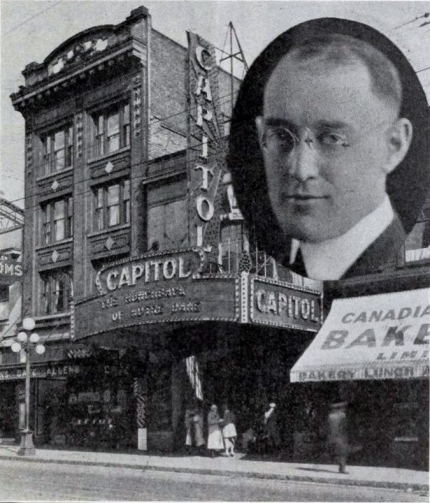
Capitol Theatre entrance c.1924 with Theatre Manager, Ralph Ruffner superimposed
The Capitol Theatre opened on March 13, 1921. The theater advertised "Two entrances and three box offices."
The theatre had two different pipe organs:
Status of the Warren instrument is unknown. The Wurlitzer was purchased by Jim Tarling of Burnaby, B.C. in 1965.
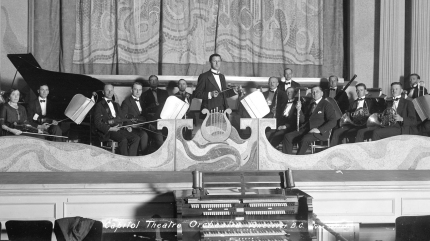
Capitol Theatre Orchestra on the stage, 1921. Note original 3/15 Warren console. Image courtesy City of Vancouver Archives
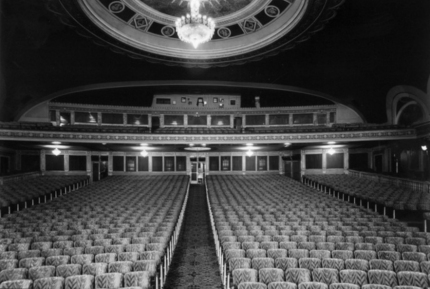
1921
Trade journals from the 1920's list various organists performing at the Capitol. For example, this news item from Canadian Moving Picture Digest, Vol 13, No 21, Mar 25, 1922, p.688
 Calvin Winters listed as being a relief organist at the Capital in 1922
Calvin Winters listed as being a relief organist at the Capital in 1922
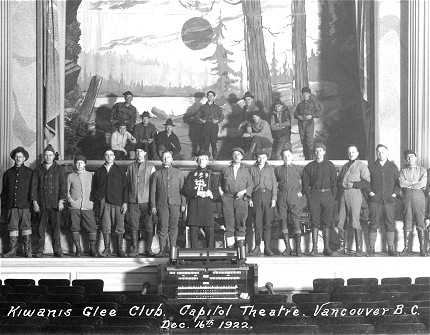
Kiwanis Glee Club on the stage, 1922. Image courtesy City of Vancouver Archives
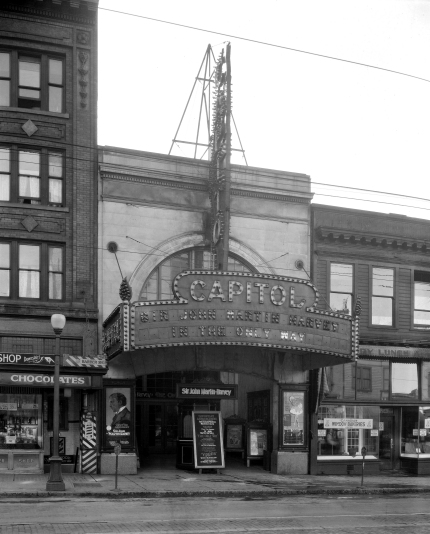
c.1926
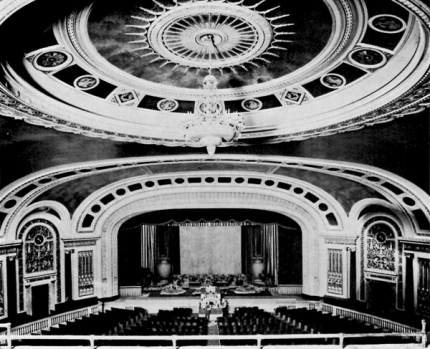
1930. Note Wurlitzer console at edge of stage
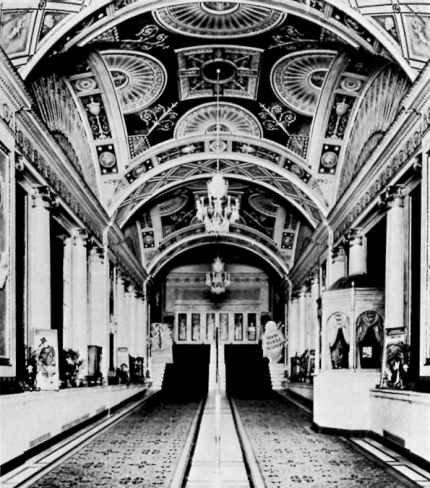
Entrance foyer, c.1930

c.1940s. Wurlitzer console horseshoe visable under protective cover at edge of stage
Brian Doctor of Surrey BC writes: "My uncle Charlie Doctor was the [Capitol Theatre] manager for 20 years from about 1947 and 1967 before passing on. I had occasion to work for the theatre in my younger days when he required help with lineups etc. I enjoyed the banter between him and Ivan Ackery at the Orpheum down the block in their endless attempts to one-up each other. I enjoyed movies in those days and spent many Saturdays in theatres."

c.1934
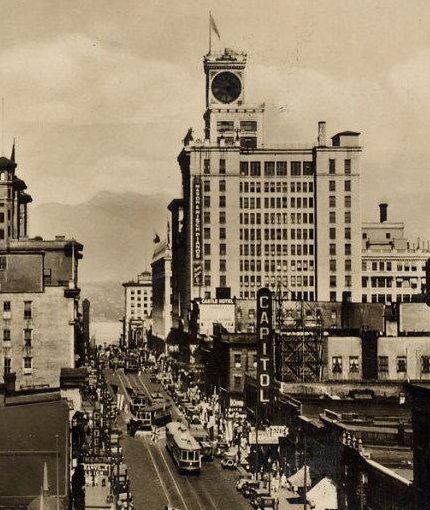
Looking North on Granville Street, early 1930s
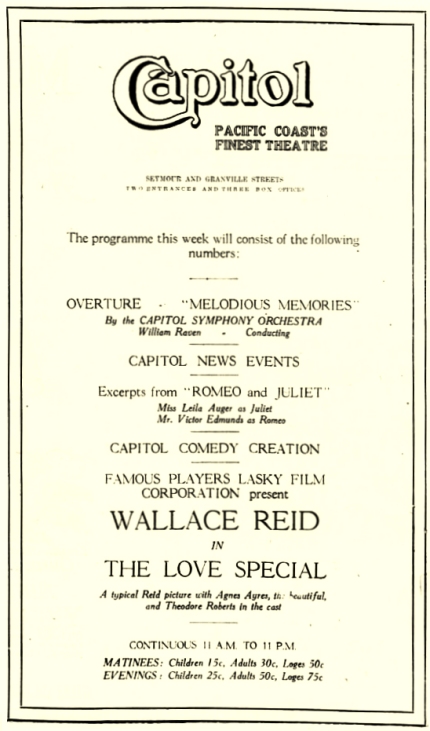
Opening Week program, March 1921
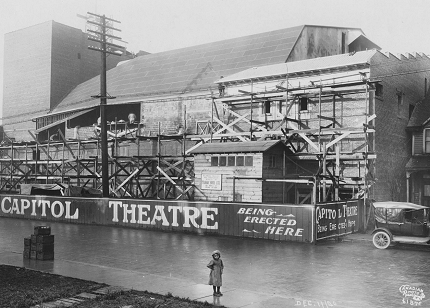
Capitol Theatre building under construction, December 11 1920, from Seymour St.
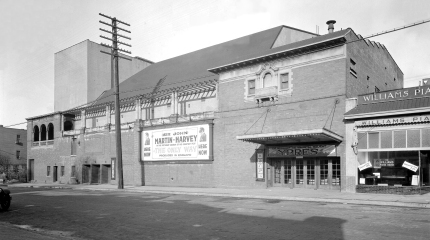
Seymour St. entrance, c.1926
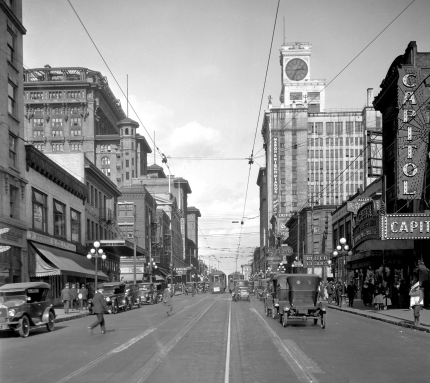
Granville Street looking north from Smithe St, 1920s
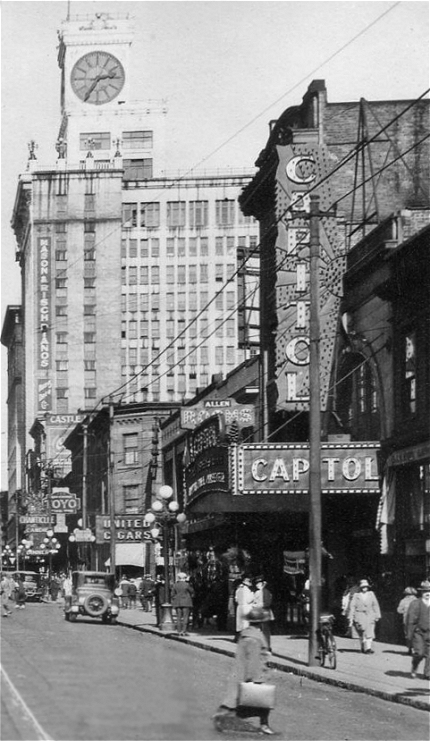
c.1920s

Looking South on Granville Street, c.1950's

Looking North on Granville Street, early 1950's
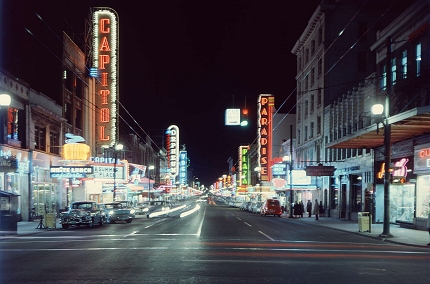
c.1959

1969
According to Alf Spence, writing to PSTOS in 2007, "Winnifred Wrenworth was the main person to play the Capitol organ in its final days."
Alf was a radio broadcast engineer, retired from the Canadian Broadcasting Corporation. He recorded Ms. Wrenworth playing the Capitol Wurlitzer on March 7th, 1956 for an audition that was to promote use of the organ and theatre for commercials on CBU, the local CBC Vancouver station.
"The program idea did not sell, and it was not long after, that the organ was removed and sold. A sad reflection of the time is that about two weeks following this recording, Miss Wrenworth took her own life. Whether or not the failure of the audition was a factor in her decision, no one will ever know."

The following article appeared in the Vancouver Courier on April 12, 2005
The End By Aaron Chapman, contributing writer

Photo-Dan Toulgoet
Nobody seemed to want the mighty Wurlitzer organ when Jim Tarling, with help from his father purchased it in 1965. it took them three months to take the organ apart and clean it before moving it to a specially built addition to the family home. When the end of the film spins off in the projection room at the Capitol 6 theatre April 15, it will be the last reel ever for the theatre on its final night of operations.
That last reel will also signal the end of an era in the district known for decades as Vancouver's "theatre row." But the sound of that last film rolling out of the projector will not compare to the sound that boomed up and down Granville Street 84 years ago.
On opening night of the Capitol Theatre, March 12, 1921, famous silent film star Wallace Reid, once billed as "the most popular screen idol in America," burst through a paper screen singing and dancing to great applause. With a blare of trumpets, the Capitol Theatre Orchestra presented an overture, and Mayor R. H. Gale took the stage stating what a great day it was for Vancouver's progress. Before the "photo-play" began, he hoped the evening would "provide a clean and uplifting picture." It was probably an earnest wish. The upheaval of the previous decade with the First World War, the Spanish flu epidemic, and housing shortages was fresh in people's minds, and the evening must have made for welcome entertainment for the 2,076 Vancouverite's in attendance. The Roaring Twenties were ready to roar.
For just 50 cents in the afternoons and 75 cents in the evening, you could have a good seat at the Capitol during the decade that saw the rise of cinema, when actors and actresses like Charlie Chaplin, Mary Pickford and Rudolf Valentino became stars.
It was an energetic time for the theatre and the young city, but little today is commonly known in Vancouver about the Capitol's early history. Most theatregoers know the theatre as an aging six-screen multiplex. Long serving as the downtown flagship theatre for Famous Players, it is closing as the chain moves its flag to its new nine-screen Paramount theatre location at the corner of Burrard and Smithe. Many people fondly remember years of watching films at the multiplex, but others also recall the Capitol's early history, when the music was live, formal dress prevailed and theatre managers battled one another with ingenious showmanship.
The Capitol was built strictly as a movie house, but it also had plenty of extra attractions.
Like other theatres downtown, the Capitol hosted vaudeville, theatre, dance contests, and especially music. Calvin Winter and his Capitolians, an orchestra that became fixtures about a year after the opening, were musical mainstays. The "jazz age" was in full swing and between Winter's group, and the pit orchestra at the Orpheum, 43 musicians worked on that block of Granville every day.
On Oct. 18, 1928 the Capitol premiered Mother Knows Best, the first talking picture to come to Vancouver. But beyond the speech of the first "talkies" there was much to be heard, such as the warm reverb of the Wurlitzer organ, which often played accompaniment to the films.
Ron Watt, now 86 and living in Oakville, Ont., recalls those nights in the late 1920s as a youngster in Vancouver attending the Capitol with his parents. "I have unforgettable memories of Ivy Evans playing the Wurlitzer theatre organ during intermissions. When the film concluded, a spotlight would be directed to centre stage, the organ would begin playing, and the console, with Ivy at the keyboard would arise from below the stage. She played for about half an hour, then the films would begin again. As a small boy, I sometimes enjoyed the organ even better than the films."
This was the original Capitol, a remarkably different place than most Vancouverites recognize today. The lush interior was one single theatre holding almost 2,500 seats, with rugs, brass railings and drapes of scarlet, velvet and gold.
"It really was just as nice as the Orpheum," says Vancouver theatre historian Norman Young. "It was lit nicely with reds and blues on the walls and the concourse entrance on Granville street was really beautiful."
Indeed, lauded British Columbian sculptor Charles Marega had done design work on both theatres.
Inside the Capitol, ushers with pillbox hats and bow ties worked the aisles. With the head usher in a long-tailed coat and a matron in the ladies room, the audiences, especially those in the more expensive seats, were normally attired in evening dress. Watt remembers how special a night at the cinema was. "Going to the movies was a much grander experience then because of the grand appearance of the theatre. Now they are small Cineplex structures, but then, when you entered the theatre you felt you were entering a 'movie palace.'"
Today most theatre managers work in obscurity, as anonymous to audiences as the projectionist. But the theatre manager of yesteryear was directly in charge of the local promotion of film premieres and advertisement, and often personally greeted the buying public.
Much of the Capitol theatre's success can be attributed to theatre manager Charlie Doctor who started as manager in 1947, and for the next 20 years stood in direct competition with his friendly rival, Orpheum manager Ivan Ackery, just a few storefronts down.
A one time Capitol usher, Ackery is perhaps better remembered than Doctor as the showman of Granville, but both men spent much of their careers continually outdoing one another with one outlandish promotion after another to advertise their theatre's films. Much of the excitement that made Granville the place to be seen can be attributed to both men.
Ticket stub holders could win everything from trips to Las Vegas to fly-fishing equipment. When a western movie was premiering, female ushers were dressed as cowgirls. When it was a period drama, actors were hired to stroll the streets in similar costumes to the movie's characters, handing out handbills and stopping passersby to "come see them at the new picture playing now..."
Ackery once marched a large milk cow up and down the front of the Orpheum. Posters on either side of the cow with arrows pointing to the udders read, "There's a great show playing at the Orpheum and that's no bull!" The city later publicly fined him $15 for breaking a city ordinance that prevented any animals on city streets, but Ackery unrepentantly claimed he got about a thousand dollars worth of free advertising.
When the Capitol theatre premiered the Elvis Presley film Love me Tender in 1956, Doctor invited all Vancouver citizens with the last name "Presley" to attend the film's premiere for free. The publicity for the Love Me Tender opening hosted by radio DJ Red Robinson made for a lineup of excited teenagers that extended down the block.
In 1965, a renovation of the Capitol theatre began, its first significant overhaul since 1930, and in many ways it signalled the death knell for the original theatre. A plan to lower maintenance costs resulted in the removal of the ornate fixtures, which had required regular bulb changes. During the renovation, the chandelier was lowered from the theatre ceiling for cleaning. It slipped from its moorings and smashed to pieces on the floor below. The costly chandelier wasn't replaced, and it was the first of a number of bad omens.
In the early 1970s, in the wake of the moon landing and "space-age" futurism, city planning and design trends tended to look to the future rather than place much value in the past, and a number of notable buildings in Vancouver were demolished. Famous Players, which owned both the Capitol and the Orpheum, decided in 1973 to carve both theatres into multiplexes. It was an economic move, and for old massive theatres not an uncommon one in the theatre business at the time. But a public outcry among local arts groups, and private citizens, including the retired Ivan Ackery, resulted in an organized drive and a multi-million dollar campaign to "Save the Orpheum." Jack Benny even flew in to do a benefit. The campaign worked, putting enough pressure on city council to convince it to purchase the theatre from Famous Players and refurbish it.
But Famous Players still wanted one theatre to convert. Most of the fight for a civic theatre went into the Orpheum, and no similar grassroots campaign arose to save the Capitol. No stars were flown in for benefits. Actor Wallace Reid, who opened the theatre, had died in 1923 after a scandalous morphine overdose, and Charlie Doctor's death just prior to his planned retirement in 1969 made it seem like there was no one to speak up on the Capitol's behalf.
The Capitol played host to one last big premiere on July 8, 1971 with Robert Altman's neo-western McCabe and Mrs. Miller, an early entry in Hollywood North that had been filmed outside West Vancouver and Squamish the year before. Large advertisements in local newspapers read "See Warren Beatty and Julie Christie In Person, plus 20 other stars" of the film, who were mostly local actors and walk-ons that made up the supporting cast.
The original Capitol closed inauspiciously on Nov. 30, 1974 with a double feature of horror films. It was completely demolished a year later to make way for the Capitol 6 multiplex. During the excavation for the new building, workers found a 1927 copy of the old B.C. Electric Co. "Buzzer" newsletter, an old-style light bulb and an empty Turret cigarette package with the date 1915 on the excise stamp.
The new Capitol 6 theatre, which most Vancouverites are familiar with, opened on St. Patrick's Day in 1977 with four levels of underground parking. It cost $6 million to build and was the first multiplex theatre in the Lower Mainland with more than three screens. The Lougheed Mall cinema in Burnaby was the first triple theatre.
The developers suggested saving the opulent Granville street entrance of the original theatre for the new Capitol, but their ideas did not come to fruition. Instead, long escalators cut through the concourse carrying ticket holders onto the Seymour Street side of the building to the individual theatres.
With the huge Cinema 1 housing 1,000 seats, and Cinemas 2 and 3 on the second floor holding approximately 500 each, the new Capitol had a total seating capacity of 3,000.
Doug Smith was theatre manager for the Capitol 6 for six years before he left in 1987. "The colour scheme was as 70s as you could get-all earth tones and browns," he says from Toronto, where he now works as Famous Players vice-president of human resources. "Carpet was specially woven so that each floor had a different colour scheme. Because the concept of multiple screens in one building was new, guests were given a coloured piece of paper with their cinema number on it that matched the carpet colour so that by following the carpet colour you would find your cinema. It sounded like a great idea but it really didn't work very well."
A few surviving remnants of the original Capitol found their way to other locations. The decorative Egyptian style smoking room benches were relocated to the Orpheum. Most remarkably, the Wurlitzer organ that had remained at the theatre since the 1920's found its way to Burnaby's Jim Tarling, who at age 20 purchased the organ with his father in 1965. "Nobody cared about it back then," Tarling says today from the organ bench at his home. It took three months of taking the organ apart and cleaning it of decades of dust before it found its way to a specially built addition in his house. "It's big, I mean, it's like owning a yacht. I would have liked to have put it somewhere more publicly, but I'm glad I have it. It's a piece of history."
Leaving the Capitol 6 after one last show, Jay Dryden has seen more movies than he can remember at the theatre. But at 31, the grip for local film and television productions is too young to remember the original building. "I'll be sad to see it go. I hear a lot of people think the building is ugly, and they say the original was better but it's all I know."
Dryden, like a lot of younger Vancouverites, is nostalgic about the Capitol 6 closing. "The insides and the mirrors and lights on the ceiling remind me a bit of the sets of A Clockwork Orange. That 1970s era design is what I remember seeing when I was a kid when I first came to see a movie here and it's kind of a time capsule for me that way."
But time moves on for theatres. Most of the old-time movie theatre palaces are gone. In the Capitol's heyday, Granville Street was home to 10 theatres within a five-block radius, with neon and line-ups stretching down the block.
Cinemagoers leaving the Capitol closing night in 2005 will empty out into a much different Granville Street than in 1921. Its neighbours, like the Plaza, the Caprice and the Paradise, are now bars. Liquor licences now hang where movie posters used to be. In the buildings where the warm hum of the Wurlitzer organ echoed, the sound of a DJ's redundant beat plays out onto the sidewalk.
When at the Capitol 6 the film unspools its last frame, it will be more than the last picture show. As with the end of the film's credits, it will truly be the end.
About this site © PSTOS, 1998-2020